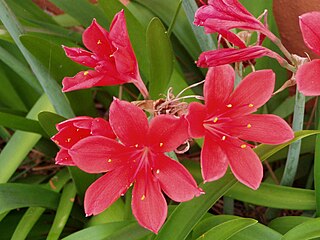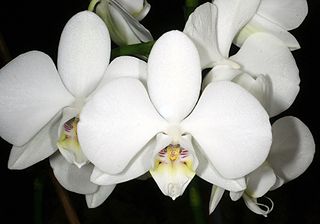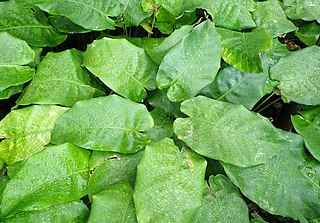
Cyrtanthus elatus, the Scarborough lily, is a bulbous flowering plant which originates from the Cape Province of South Africa. Other common names are fire lily and George lily.

Ceropegia woodii is a flowering plant in the dogbane family Apocynaceae, native to South Africa, Eswatini and Zimbabwe. It is sometimes treated as a subspecies of the related Ceropegia linearis, as C. linearis subsp. woodii. Common names include chain of hearts, collar of hearts, string of hearts, rosary vine, hearts-on-a-string, and sweetheart vine.

Allium cristophii, the Persian onion or star of Persia, is a species of flowering plant in the family Amaryllidaceae, native to Iran, Turkey, and Turkmenistan, though grown as an ornamental bulbous plant in many parts of the world. It may be sold under the synonym of Allium albopilosum.
Goeppertia libbyana is a species of flowering plant in the family Marantaceae, endemic to Napo Province of Ecuador. Its natural habitat is subtropical or tropical moist lowland forests. It has gained the Royal Horticultural Society's Award of Garden Merit.

Phalaenopsis amabilis, commonly known as the moon orchid, moth orchid, or mariposa orchid, is a species of flowering plant in the orchid family Orchidaceae. It is widely cultivated as a decorative houseplant. It is an epiphytic or lithophytic herb with long, thick roots, between two and eight thick, fleshy leaves with their bases hiding the stem and nearly flat, white, long-lasting flowers on a branching flowering stem with up to ten flowers on each branch.

Goeppertia makoyana, also known as peacock plant or cathedral windows, is a species of plant belonging to the genus Goeppertia in the family Marantaceae, native to Espírito Santo state of eastern Brazil. It has gained the Royal Horticultural Society's Award of Garden Merit.

Goeppertia louisae is a species of plant belonging to the genus Goeppertia, native to Rio de Janeiro state of southeast Brazil but cultivated in other places as an ornamental.

Goeppertia loeseneri, the Brazilian star calathea, is a species of plant belonging to the Marantaceae family. It is native to Peru, northern Brazil, Colombia, and Ecuador. It can grow to a height of 1.2m.

Goeppertia ornata is a species of perennial plant in the family known as the prayer plants. It is native to South America, and is cultivated in temperate countries as a houseplant.

Yucca gigantea is a species of flowering plant in the asparagus family, native to Mexico and Central America. Growing up to 8–12 m (26–39 ft) in height, it is an evergreen shrub which is widely cultivated as an ornamental garden or house plant, often referred to simply as yucca cane. The edible flower is the national flower of El Salvador locally called izote, and it is used extensively in Salvadoran cuisine.

Ctenanthe oppenheimiana, the giant bamburanta or never-never plant, is a species of flowering plant of family Marantaceae and is a native of Brazil. It is an evergreen perennial. This plant can grow to more than 1 m (3.3 ft) tall and broad, with long narrow leaves up to 40 cm (16 in) in length. The leaves are adorned on the secondary veins with dark green bands, which meet and merge in the margins. In between are cream coloured bands. The undersides of the leaves have a red-ish colour. The cultivar ‘Tricolor’ is a common ornamental variety, which as a houseplant in the UK has gained the Royal Horticultural Society’s Award of Garden Merit.. This cultivar is visually very similar to Stromanthe Sanguinea 'Triostar', and the two are often confused. The difference between the two lies in the lack of regular banding on the leaves of the Sromanthe, and the generally more rounded shape of the leaves in Ctenanthe.

Goeppertia insignis, the rattlesnake plant, is a species of flowering plant in the Marantaceae family, native to Rio de Janeiro state in Brazil.

Calathea zebrina, the zebra plant, is a species of plant in the family Marantaceae, native to southeastern Brazil. Under the synonym Goeppertia zebrina this plant has gained the Royal Horticultural Society's Award of Garden Merit.
Richard Wilford is a horticulturist with a specialist interest in montane plants and geophytes, who is a collections manager at the Royal Botanic Gardens, Kew. He is on the editorial committee of Curtis's Botanical Magazine and Kew Magazine and a member of the Royal Horticultural Society Daffodil and Tulip Committee.

Calathea picturata is a species of plant in the family Marantaceae, native to northwest Brazil. It is a clump-forming evergreen perennial growing to 35–40 cm (14–16 in). The leaves are dark green above, purple below, marked heavily with silver along the veins and midriff. It is tender, with a minimum temperature of 16 °C (61 °F) required, and in temperate areas is cultivated indoors as a houseplant.

Maranta leuconeura, widely known as the prayer plant due to its daily sunlight-dependent movements, is a species of flowering plant in the family Marantaceae native to the Brazilian tropical forests. It is a variable, rhizomatous perennial, growing to 30 cm (12 in) tall and broad, with crowded clumps of evergreen, strikingly-marked oval leaves, each up to 12 cm (5 in) long. The plant spreads itself horizontally, carpeting an entire small area of forest floor, sending roots into the substrate at each leaf node.
Edward Martyn Rix is a British botanist, collector, horticulturist and author. Following completion of a PhD on Fritillaria at Cambridge University, he worked in Zurich, Switzerland and at the Royal Horticultural Society gardens at Wisley. He is the author of many books and articles on plants and horticulture and is the editor of Curtis's Botanical Magazine, based at the Royal Botanic Gardens, Kew in London.

Goeppertia kegeljanii is a species of flowering plant in the family Marantaceae. Native to Espírito Santo in Brazil, it is commonly also known by its synonym Calathea mosaica in the houseplant trade, due to the mosaic-like patterning on its leaves. As an ornamental plant, it is noted for its light green, oval leaves with a fine venation of yellow.

Goeppertia roseopicta is a species of plant in the family Marantaceae, native to northwest Brazil. It is marketed as a houseplant under its synonym Calathea roseopicta. It is a clump-forming evergreen perennial growing to 50 cm (20 in), very similar in appearance to Goeppertia makoyana. The large rounded leaves are dark green above, red below, marked heavily with cream or pink stripes "painted" along the veins and midrib, with feathered margins.

Goeppertia majestica, the majestic prayer plant, is a species of flowering plant in the family Marantaceae. It is native to Colombia, Ecuador, Peru, Bolivia, Guyana, and northern Brazil, and has been introduced to Venezuela. A large member of its genus, it has gained the Royal Horticultural Society's Award of Garden Merit.

















